What are the Seven Tools for Quality Management?
|
The so-called Seven Tools for Quality Management form a basis for overall TQM methodology. In general, all the tools are based on two major approaches: statistics and team involvement. We can formulate their major goal as a set of instruments to unite the team around some of the quality issues for discussion, prediction, and preventive actions concerning potential project or product quality problems.
The major tools are the flowchart, the cause-and-effect (fishbone or Ishikawa) diagram, the Pareto diagram, the check sheet, the scatter diagram, the histogram, and the control chart.
Flowcharts and cause-and-effect diagrams are used in quality planning and quality assurance processes; the remainder, control charts, check sheets, etc., are used as instruments of quality control.
Tell me more …
A flowchart is a quality management tool that allows the team to look more closely at certain processes, to identify the events and steps in the processes, and to show places for data collection and possible interdependency and points of complexity. Everybody who has studied computer science in school knows how to do flowcharts. In order to do it, you need to get the group of people interested in getting more information about the process together; then, after some brainstorming, you finally determine the steps for the process and their sequence. Now the only thing to be done is to draft the chart on a sheet of paper.
In the example shown in Figure 9-3, we are looking at a Russian roulette game as a process with a number of necessary steps and decisions on how to carry on with a process. The example given is the Russian version, which is a much tougher version of the game than Americans are used to.

Figure 9-3: SEVEN TOOLS FOR QUALITY MANAGEMENT. FLOWCHART: "RUSSIAN ROULETTE"
The cause-and-effect diagram was developed by a Japanese manager by the name of Kaoru Ishikawa as a means of allowing the project team to accumulate all the knowledge it has about some potential causes of a problem and then graphically display it in a useful way. The diagram allows us to concentrate the attention of the group on the problem itself, not its symptoms. It really does look like a skeleton of a fish with the head as a problem discussed and the bones showing all the potential causes that came to mind.
In order to do the cause-and-effect diagram properly, the team needs to select the problem, brainstorm it in order to get all the potential causes from the group members, rank the reasons and place them on the diagram in ranked order, and then explore any branch of the diagram more deeply if someone feels one branch is more important than the others.
In Figure 9-4, we show an example of building a cause-and-effect diagram for a car wreck with the major sources of the problem being the weather, the state of a driver himself, something happening with parts of the car, other drivers, and so on.
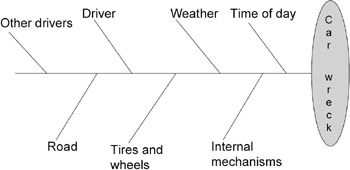
Figure 9-4: SEVEN TOOLS FOR QUALITY MANAGEMENT. FISHBONE DIAGRAM: CAR WRECK
A Pareto chart, or diagram, shown in Figure 9-5, is used in order to select the most important problem areas of the project that can cause the most pain. It is based on the well-known 80-20 rule, which says that 20 percent of the problems are responsible for 80 percent of the total cost of the project's problems. The diagram thus explores all the potential problem areas of the project according to the number of their occurrences. The problem areas are ranked according to that number and then plotted on the diagram as in a frequency diagram. The upper part of the diagram shows cumulative cost for the problems measured in the percentage of the total cost of whatever it is being measured against.
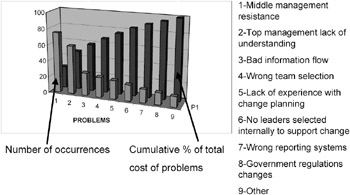
Figure 9-5: SEVEN TOOLS FOR QUALITY MANAGEMENT. PARETO CHART: ORGANIZATIONAL TRANSFER IN COMPANY A
We are looking for all the possible problems with an organizational change happening in corporation A. It is easy to see that the first and second problems are the most significant considering their contribution to the overall result.
The check sheet is an instrument for collecting data on some process or, more often, on certain problems happening within the process. The check sheet is actually a sheet of paper on which all the potential problems of the process are listed. The person carrying out the facilitator function looks at the process at random times and records the results on the sheet. This method allows us to see if there are some problems occurring repeatedly in the process. As these problems are identified, we look deeper for the causes and potential tendencies using either a cause-and effect diagram or some of the statistical tools we will talk about later.
In Figure 9-6 we show an example of various problems associated with serving a hamburger at a fast-food restaurant.
| 1 | Meat missed | √√√ |
| 2 | Mayonnaise forgotten | |
| 3 | Salad items forgotten | √√ |
| 4 | Meat overcooked | √√√√ |
| 5 | Meat undercooked | |
| 6 | Served cold | √ |
| 7 | Sereved too hot | √ |
Figure 9-6: SEVEN TOOLS FOR QUALITY MANAGEMENT. CHECK SHEET: BAD HAMBURGERS
The scatter diagram is used when we need to analyze two characteristics of a process and see if there is any interdependency between them. In this case, the observed data must be collected on both characteristics. It is important that the pairs of data being collected are random with no time or other dependency present. The overall pool of data is then represented as a group of points set up on a plot of two variables. After the plot is developed, by looking at the pattern of the points, you can make general conclusions if the two parameters correlate and if this is a positive versus negative as well as a strong versus weak correlation.
In Figure 9-7 we look at various types of correlation between the two parameters of a production process—temperature and humidity.
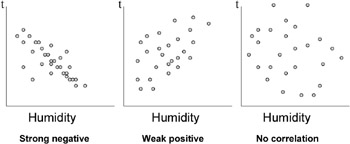
Figure 9-7: SEVEN TOOLS FOR QUALITY MANAGEMENT. SCATTER DIAGRAMS: HUMIDITY VS. TEMPERATURE
The last two of the seven tools—a histogram and control chart—are the most statistically oriented of all the quality tools. A histogram is used when we are dealing with a need to analyze large sets of data. It gives the observer an opportunity to see the frequency of occurrence of each value; more important, it shows the centering and dominance of values as well as the level of data and correspondingly the process dispersion.
In order to build a histogram (shown in Figure 9-8), you first need to collect enough data on the parameter of the process you are interested in measuring and viewing. While doing this, you have to make sure there are no outside influences that might bias the data. The number of data points is normally not less than a hundred. Then you have to determine the range of values, the number of classes, and the size of intervals and plot the data as a set of bars, each of which corresponds to the frequency of occurrence of certain values of the parameter observed.
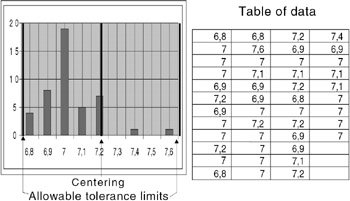
Figure 9-8: SEVEN TOOLS FOR QUALITY MANAGEMENT. HISTOGRAM: HISTOGRAM WITH SHIFTED CENTERING. CERTAIN ASSIGNABLE CAUSES FOR PROCESS NONSTABILITY TO BE EXPLORED
After the histogram is built, you can look at various characteristics of the chart and see if this parameter stays within the limits you set up for it. The comparison of the overall range of values for the parameter to the normal limits set up for this process will show you how much the process is out of control, in other words, whether the variability is in, closely in, or out of the allowable tolerance. The shifts of data centering also show you if the data are out of control and if some special causes are present that influence the process and must be attended to.
To explain the last statement, as well as to better understand the last of the seven tools, the control chart, we have to define a special or assignable cause and the difference between it and a common cause. In any process, both in management and in production, there is some normal variance that results from the nature of the process. This variance creates an acceptable error in the final product that is being considered by engineering tolerance. The causes for such variances are called common causes. These causes normally do not attract our attention and do not show that the process is getting out of control. Among possible common causes in the production process we can name:
-
Temperature controlled by thermostat
-
Part diameter within specification
-
Tolerance of electrical resistance, capacitance
-
Operator differences
-
Different vendor for materials
-
Machinery looseness
The special or assignable causes show some external interference or internal error in the process that could finally lead to producing a product defect. The occurrence of a special cause is a signal for us to check the process. The list of assignable causes may involve:
-
Machine tool worn
-
Lack of training
-
Mistake
-
Operator error
-
Breakdown (of anything)
-
Bad material
Now that we understand the nature of a special cause and how important it is to control these causes for overall process quality control, we can move to reviewing the last of the seven tools. The control chart actually develops the idea of controlling the process onto a new level where we want to prevent and predict potential problems and scrap long before they are ever produced. In doing control charts, it is important to understand that we can use them only when the control limits we set up for our process are well within the acceptable tolerance level for this measurement. In other words, when our process is initially pretty well controlled and the mechanisms and tools we use are relevant. It is also important to remember all through the process of developing the control chart that we are looking at the process during a time when it is actually under control and not producing defects. In order to do this, we have to start with a 100 percent sample of a lot of parts in order to determine that the lot is 100 percent good. When this is done, we take a number of samples from the "good" lot. Twenty to twenty-five samples of four or five parts each that are randomly selected will generally be adequate. We then measure each of the parts selected. For each sample, then calculate the average (X) and the difference between the highest and lowest value (R) of the measurement. This is the range. After this, we can calculate the average of the samples' averages (X bar) and average of the samples' ranges of values (R bar).
In order to calculate upper and lower control limits (UCL and LCL) for the chart that we are going to use to control our process, we will need to determine the standard deviation and set the upper and lower control limits at the points plus and minus three standard deviations. We could calculate the standard deviation but quality assurance engineers seldom, if ever, do this. Instead they use standard formulas and tables that can be found in most quality manuals.
After calculating the UCL and LCL, the next step is to build up the two parts of the control chart, one for average (X), the X bar chart, and the variance (R), the R chart of the measurement that is being controlled as it is shown in Figure 9-9.

Figure 9-9: SEVEN TOOLS FOR QUALITY MANAGEMENT. CONTROL CHARTS: BUILDING A CONTROL CHART
After the upper and lower control levels are set up on the charts, you start taking samples from a normal production lot of parts you want to control. Of course it is important to remember to take the samples on a random basis. Measure the measurements you are viewing, calculate the average and the range of values for each sample, and plot it on the chart. Generally, as long as the points are within the UCL and LCL you may be confident that your process is working well and no special causes are influencing it. However, there are a number of other ways of looking at data that show quality control people that there is some tendency in the process that may represent the need to be further explored (see Figure 9-10).
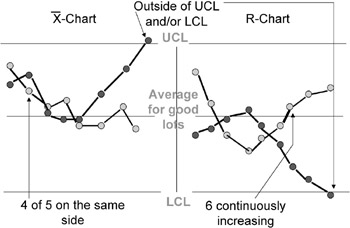
Figure 9-10: SEVEN TOOLS FOR QUALITY MANAGEMENT. CONTROL CHARTS: SOME PATTERNS INDICATING NONSTABLE PROCESS
The last thing that needs to be said about the control chart is that although it looks very production-oriented, it can not only be used for production processes, but can also be applied to some of the management processes and thus becomes an important tool for managing projects as well. Of course, as we have already said, we can apply this technique to the process only in cases where the process is initially clearly described and well controlled and where the instruments used are relevant and well developed; in other words, from the management processes we need to choose those with the least uncertainty and best developed mechanisms, like the earned value reporting or estimating system.
To conclude the observation of the tools, it is important to once again point out that although these tools seem strongly mathematical and statistically based, we are using them primarily with the aim of centering our team on some problems and determining some zones for our special managerial attention as project managers. In other words, we use these tools as management tools, not as tools of statistical analysis. That's why in real projects we need to pay more attention to the actual application of the tools for working with people and less attention to the scientific background.
|
EAN: 2147483647
Pages: 126